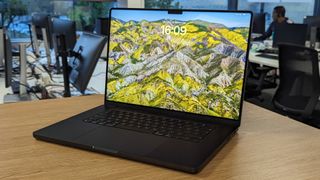Apple’s Mac mini has just seen its largest-ever overhaul, with a massively shrunk-down design and brand-new M4 and M4 Pro chips taking its performance to new levels. And if you read between the lines, there are a few nuggets tucked away in the Mac mini’s spec sheet that point towards what we can expect when the MacBook Pro is updated later today.
Firstly, let’s talk about memory. Apple has found itself in hot water in recent times over its insistence on sticking with 8GB as a base level for its Macs’ memory, but that’s all changed, first with the M4 iMac and now with the Mac mini.
Both computers start with a much roomier 16GB of memory, and previous leaks have suggested that the MacBook Pro will get the same. Given that two of Apple’s new M4 Macs now come with 16GB as standard, it would be shocking if the MacBook Pro didn’t follow suit.
And that’s not all. If you opt for a higher-spec version of the Mac mini – that is, any configuration with the M4 Pro chip – you’ll get 24GB of memory included, a boost of 8GB over the entry-level M4 Mac mini.
Meanwhile, in the M3 Pro version of the MacBook Pro, you get 18GB of RAM (up from the 8GB in the M3 MacBook Pro), so it looks like Apple is continuing its tradition of ramping up the RAM in the Pro versions of its Mac chips. With the M4 Pro Mac mini getting 24GB of memory, this will almost certainly carry over to the MacBook Pro and its M4 Pro configuration.
A bolt from the blue

When it comes to the MacBook Pro, there’s a lot more we can read in the M4 Mac mini’s tea leaves. For instance, the Mac mini with the M4 Pro chip supports Thunderbolt 5, and we can expect to see this in the MacBook Pro as well.
That’s because it would be highly unusual for Apple to bring this ultra-fast connectivity standard to the Mac mini but not to its flagship MacBook Pro, especially since Apple likes to market its high-end laptops towards professional users for whom Thunderbolt 5 would provide real, tangible benefits.
Finally, the addition of Thunderbolt 5 allows the Mac mini to support up to three external displays running at 6K resolution and a 60Hz refresh rate. If the MacBook Pro does indeed adopt Thunderbolt 5, that means it will also be able to run a similar display arrangement, allowing you to create a multi-monitor setup without having to close the laptop’s lid (as is the case with the current MacBook Pro).
While these points are all educated guesses, we’ll know for sure in a few hours’ time when Apple unveils the new M4 MacBook Pro to the world. It’ll be the culmination of a week’s worth of M4 announcements, so be sure to check back for more details later today.